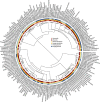Cooperative secretions facilitate host range expansion in bacteria
- PMID: 25091146
- PMCID: PMC4143932
- DOI: 10.1038/ncomms5594
Cooperative secretions facilitate host range expansion in bacteria
Abstract
The majority of emergent human pathogens are zoonotic in origin, that is, they can transmit to humans from other animals. Understanding the factors underlying the evolution of pathogen host range is therefore of critical importance in protecting human health. There are two main evolutionary routes to generalism: organisms can tolerate multiple environments or they can modify their environments to forms to which they are adapted. Here we use a combination of theory and a phylogenetic comparative analysis of 191 pathogenic bacterial species to show that bacteria use cooperative secretions that modify their environment to extend their host range and infect multiple host species. Our results suggest that cooperative secretions are key determinants of host range in bacteria, and that monitoring for the acquisition of secreted proteins by horizontal gene transfer can help predict emerging zoonoses.
Figures




References
-
- Smolinski M. S., Hamburg M. A. & Lederberg J. Microbial Threats to Health: Emergence, Detection, and Response National Academies Press (2003). - PubMed
-
- Binder S., Levitt A. M., Sacks J. J. & Hughes J. M. Emerging infectious diseases: public health issues for the 21st century. Science 284, 1311–1313 (1999). - PubMed
Publication types
MeSH terms
Grants and funding
LinkOut - more resources
Full Text Sources
Other Literature Sources

